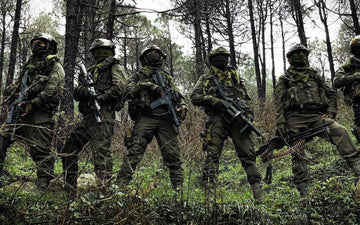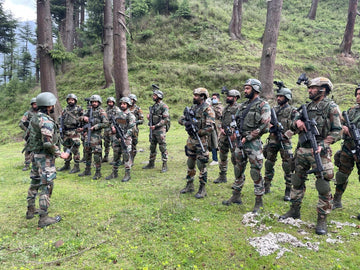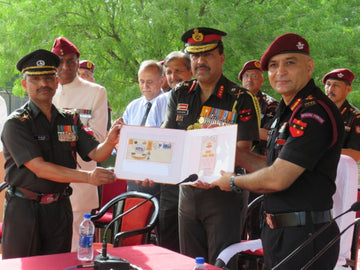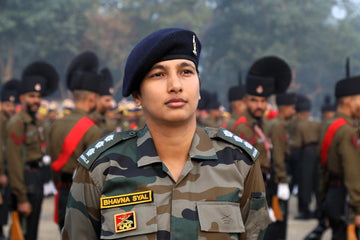The Indian Air Force (IAF) stands as one of the key components of India’s armed forces, playing a crucial role in safeguarding the nation’s airspace and supporting its military operations. With its operational prowess and cutting-edge technology, the IAF is an emblem of strength and capability. As with any organized military structure, the IAF operates on a well-defined system of ranks and insignia that clarify roles, responsibilities, and hierarchy. This detailed guide explores the ranks and insignia within the IAF, aiming to provide clarity and insight into this fascinating aspect of the Indian military.
Historical Context
The Indian Air Force was established on October 8, 1932, under the British rule. Initially, it was a small force, significantly limited in scope and capability. However, as India gained independence in 1947, the IAF began to evolve into a modern air force equipped to meet the country's security needs.
Today, the IAF ranks among the top air forces globally, crucial for various operations—from disaster relief to combat missions. The rank structure has evolved alongside the growth of the IAF, reflecting both its historical legacy and contemporary requirements. Understanding the ranks and insignia of the IAF is essential not only for personnel within the organization but also for those who wish to understand the overarching structure of India's military force.
Officer Ranks
The officer ranks within the Indian Air Force represent the leadership structure and command hierarchy. Each rank is pivotal in ensuring smooth operations and effective management. The ranks from the highest to the lowest are as follows:
1. Marshal of the Indian Air Force
- Overview: The highest honorary rank in the IAF, equivalent to the Field Marshal in the Indian Army and Admiral of the Fleet in the Navy, is conferred typically in wartime.
- Insignia: The insignia consists of five stars, symbolizing the highest level of authority, and a unique emblem that encompasses the responsibilities of air warfare.
- Notable Holder: The only individual to have received this rank is Arjan Singh, who was honored in 2002, reflecting the significance and rarity of this title.
2. Air Chief Marshal
- Overview: Holding a four-star rank (NATO OF-9), the Air Chief Marshal is the head of the Indian Air Force, responsible for its operational readiness and strategic direction.
- Insignia: The insignia features four stars, a sword, and an eagle, symbolizing power and leadership over the air forces of the nation.
3. Air Marshal
- Overview: This three-star rank (NATO OF-8) typically includes officers commanding major IAF commands.
- Insignia: The insignia incorporates three stars, a sword, and the Ashoka emblem, which reflects the honor and responsibility held by the position.
4. Air Vice Marshal
- Overview: As a two-star rank (NATO OF-7), the Air Vice Marshal plays a central role in strategic oversight, typically directing specific units or wings within the IAF.
- Insignia: The insignia consists of two stars above a single stripe and a wreath.
5. Air Commodore
- Overview: A one-star rank (NATO OF-6), responsible for regional operations and command over significant units within the Air Force.
- Insignia: The insignia is characterized by one star, a stripe, and a wreath.
6. Group Captain
- Overview: With a NATO ranking of OF-5, Group Captains serve as leaders for larger bases or units.
- Insignia: The insignia features four stripes, a larger wreath, and the Ashoka emblem.
7. Wing Commander
- Overview: The rank of Wing Commander (NATO OF-4) is often in charge of squadrons and specialized missions.
- Insignia: Wing Commanders wear three stripes on their insignia.
8. Squadron Leader
- Overview: As a mid-level officer (NATO OF-3), the Squadron Leader commands flights or smaller operational units within squadrons.
- Insignia: The insignia comprises two stripes.
9. Flight Lieutenant
- Overview: A junior officer rank (NATO OF-2) often tasked with flying duties or leading specific missions.
- Insignia: Flight Lieutenants wear a single stripe.
10. Flying Officer
- Overview: This rank represents the entry point for commissioned officers (NATO OF-1) and often involves intensive training and operational duties.
- Insignia: The insignia for a Flying Officer is quite simple, signifying their nascent status in the IAF hierarchy.
Airmen Ranks
Airmen constitute a vital part of the IAF personnel, coming with dedicated duties and specific skill sets. Their hierarchical ranks include:
1. Master Warrant Officer
- Overview: As the highest rank achievable for airmen, Master Warrant Officers usually fill critical leadership and advisory roles comparable to that of a Brigadier.
2. Warrant Officer
- Overview: Below the Master Warrant Officer, this rank encompasses senior non-commissioned officers with broad responsibilities across various specialties.
3. Junior Warrant Officer
- Overview: Similar in function to Warrant Officers albeit with lesser authority, Junior Warrant Officers often work closely with their seniors to ensure smooth operations.
4. Sergeant
- Overview: This rank (equivalent to a mid-level NCO) involves supervising airmen and managing ground operations effectively.
5. Corporal
- Overview: Serving as junior non-commissioned officers, Corporals assist in leadership and oversee specific tasks within their teams.
6. Leading Aircraftman
- Overview: As the rank positioned just above the basic airman, Leading Aircraftmen have a mix of supervisory duties and operational responsibilities.
7. Aircraftsman
- Overview: This is the entry-level rank for airmen who are involved in various duties under the guidance of their superiors.
Non-Commissioned Officers (NCs(E))
The IAF also incorporates Non-Commissioned Officers in the Technical branch (NCs(E)), who undertake specialized technical roles essential for operational efficiency. Positions include NC (E) Tindal and NC (E) ranks, which are fundamental in technical expert roles within the IAF.
Insignia and Symbols
Each rank within the IAF is represented by distinct insignia elements, which facilitate immediate recognition of personnel hierarchy.
- Stars: Indicate the level of authority—more stars correspond to higher ranks.
- Stripes: Represent the progression through the ranks, particularly among officers and airmen, with a standardized policy for representation.
- Wreaths and Swords: Symbols that denote command; wreaths are often associated with leadership, while swords signify readiness and defense preparedness.
- Ashoka Emblem: A symbol of national pride and allegiance, often seen in higher ranks, reinforcing the connection to the nation and its duties.
NATO Rankings
For effective international collaboration and standardization, the Indian Air Force ranks align with NATO rankings. This means that the hierarchical structure of the IAF is comparable to allied forces, facilitating joint operations and interoperability. For instance, the Marshal of the IAF corresponds to NATO’s OF-10, Air Chief Marshal to OF-9, and so forth down to Flying Officer at OF-1.
Case Studies and Real-World Applications
The structured hierarchy within the IAF plays an essential role in operational effectiveness. For example, during the Kargil War (1999), the IAF’s aerial operations were meticulously planned and executed under the supervision of senior ranks like the Air Chief Marshal and Air Vice Marshals. Their strategic decisions and command of resources were crucial in ensuring air superiority and providing support to ground forces during the conflict.
Moreover, aircraft operations involving multiple units necessitated a clear understanding of ranks, roles, and responsibilities, where Group Captains and Wing Commanders oversaw the operational aspects, while Sergeants and Corporals managed the frontline tasks.
Statistical Data and Research Insights
The Indian Air Force has continued to grow in both strength and capability. Currently, the IAF comprises approximately 170,000 personnel, structured to handle various operational demands effectively. According to the International Institute for Strategic Studies (IISS), the IAF operates around 600 combat aircraft, including advanced fighter jets like the Sukhoi Su-30MKI, which further emphasizes the need for an organized and well-defined rank structure to manage such complex assets effectively.
Challenges and Solutions
Despite the well-structured rank system of the IAF, several challenges persist. High turnover rates and recruitment issues can impede operational continuity and leadership stability.
- Challenge: With the increasing privatization of the aviation sector, attracting and retaining skilled personnel becomes a pressing concern.
- Solution: The IAF could implement competitive compensation packages and enhanced career development programs to appeal to potential recruits. Furthermore, establishing partnerships with educational institutions for training and internships might attract young talent.
Future Trends and Predictions
As the Indian Air Force prepares for future warfare, incorporating advanced technologies like artificial intelligence (AI), drones, and enhanced cyber capabilities will remain pivotal.
With this evolution, the rank structure may also adapt, potentially introducing new specialized ranks catering to niche areas such as cyber warfare or unmanned aerial systems (UAS). This could lead to a more dynamic hierarchy and facilitate the integration of cutting-edge technologies within existing frameworks.
Conclusion
The ranks and insignia of the Indian Air Force serve as more than just symbols of authority; they signify an established order essential for effective military operations and governance. Each rank, from the illustrious Marshal of the Indian Air Force down to the dedicated Aircraftsman, plays an indispensable role in ensuring operational readiness.
For those aspiring to join the armed forces, understanding the rank structure is critical to navigating one's career in defense. Through pursuing education, training, and personal development, future air warriors can aspire to climb this well-defined hierarchy within the Indian Air Force. As the IAF continues to evolve, embracing modernization while holding steadfast to its traditions, the rank structure will remain a cornerstone of its strength. Thus, those looking to learn more can turn to resources like SSBCrack and SSBCrackExams for valuable study materials, online courses, and eBooks that prepare candidates for joining this esteemed organization.





